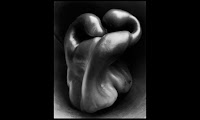The combination of Weston’s stark objectivity and his passionate love of nature and form gave his still lifes, portraits, landscapes, and nudes qualities that seemed particularly suited for expressing the new American lifestyle and aesthetic that emerged from California and the West between the two world wars. He spent the years 1923–1926 in Mexico City as a part of an international milieu of creative minds attracted by the post-revolutionary excitement of political activists and artists such as Diego Rivera, Jose Clemente Orozco, Tina Modotti, and others. From the moment he returned to the United States, he began making work that would fundamentally change the direction of photography in this country.
In Weston's still lives, for instance, the tonal quality of his black-and-white prints imbue everyday objects, both natural and man-made, with a heightened presence that sometimes makes them seem almost unreal. In his journals, he wrote that his aim was to render "the very substance and quintessence of the thing itself, whether it be polished steel or palpitating flesh".
When he turned his camera on a humble green pepper, he made it look like a modernist sculpture by Hans Arp. In his journal, he wrote, "It is classic, completely satisfying – a pepper – but more than a pepper: abstract, in that it is completely outside subject matter."
The notion of a subject, even one belonging to the natural world like a pepper or a seashell, being "completely outside subject matter" is intriguing. Revealingly, Weston also wrote that something as ordinary and as extraordinary as a pepper "takes one beyond the world we know in the conscious mind".
Of his famous pepper, Weston wrote: “I must get this one today: it is beginning to show the strain and tonight should grace a salad. It has been suggested that I am a cannibal to eat my models after a masterpiece. But I rather like the idea that they become a part of me, enrich my blood as well as my vision.”
Weston was given a Kodak box camera for his 16th birthday by his father. Within a year, he was photographing the parks in his native city on a 5in by 7in camera, and, aged 18, had the resulting work published in a photographic magazine. His only formal training was a short stint at the Illinois School of Photography. Initially, Weston had been a leading exponent of Pictorialism – a kind of arty, romanticized style of portraiture that took its cue from the Victorian painters like Whistler.
Weston began to turn his camera on the everyday things around him: household objects as well as the flora and fauna of the country's arid landscape. Weston became absorbed by the camera's ability to capture, in arresting close-up, the otherness of the country's plant and vegetable life as well as rock and cloud formations. An aesthetic was born.
On his return to California, he continued to use his camera as a means to express "the very substance and the quintessence of the thing itself", photographing in close-up what he saw around him: an egg-slicer, a toadstool, a cup, a gnarled tree. In 1930, his lover, Sonya Noskowiak, brought him some green peppers to photograph, the most famous of which, Pepper No. 30, he transformed into a sensual object with curves that echo both modernist sculpture and the human form. Here, ultra-realism shades into surrealism.
Image Recreation - Onion Halved. Photoshoot 1.
 |
| Onion Halved - 1930. |
Below: My Onion Images.
I changed composition and camera angles for this shoot. I dried out the onion so the creases between each segment allowed me to achieve the harsh shadows in the curves, as Weston has. In post production, I converted my images to black and white and added some adjustments to the levels. I used a digital camera, standard lens, but also a macro lens. I had my shutter speed at 125, my ISO at 200, but changed to 400 just to add abit more light, and my aperture around 8. My series of images, have shown me a lot now what I need to improve on in terms of bringing out more details and textures of the onion, focusing more on light and where the light is bouncing off the subject and the technical aspects + visual approach to my subjects.
Although, I have chose to recreate a photograph from Weston's still life era of his career, I would also like to try and recreate 1 or 2 of his series of nudes, something which I am going to try out before the hand in, to see which image will be my final image, and from which style of Weston's images I have decided on.






No comments:
Post a Comment